
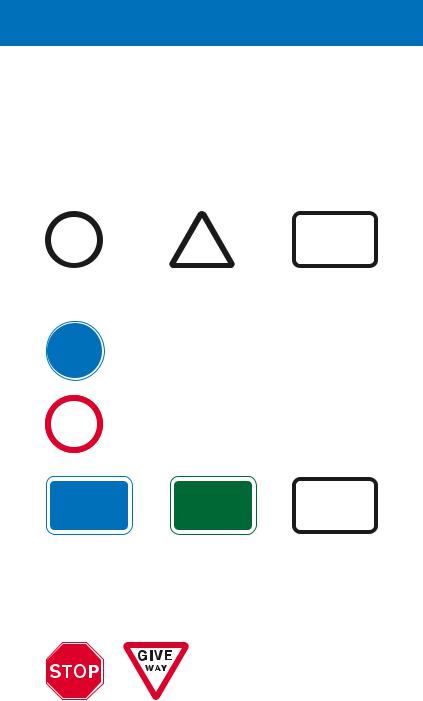
the signing system
The signing system
There are three basic types of traffic sign: signs that give orders, signs that warn and signs that give information. Each type has a different shape. A further guide to the function of a sign is its colour. All triangular signs are red.
Circles |
Triangles |
Rectangles |
give orders |
warn |
inform |
Blue circles generally give a mandatory instruction, such as “turn left”, or indicate a route available only to particular classes of traffic, e.g. buses and cycles only
Red rings or circles tell you what you must not do, e.g. you must not exceed 30 mph, no vehicles over the height shown may proceed
Blue rectangles are |
Green rectangles |
White rectangles are |
used for information |
are used for |
used for direction |
signs except on |
direction signs on |
signs on non-primary |
motorways where |
primary routes |
routes, or for plates |
blue is used for |
|
used in combination |
direction signs |
|
with warning and |
|
|
regulatory signs |
There are a few exceptions to the shape and colour rules, to give certain signs greater prominence. Examples are the “STOP” and “GIVE WAY” signs
The words “must” or “must not”, when used in the descriptions that follow, refer to legal requirements that have to be obeyed.
9
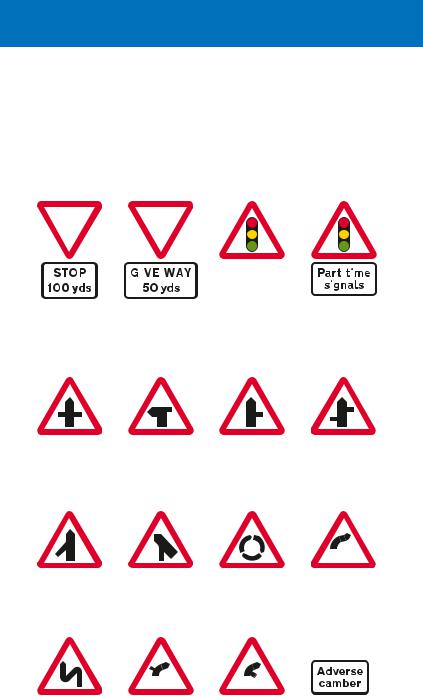
Warning signs
(other than those for low bridges, railway and tramway level crossings, bus and pedal cycle facilities, traffic calming and road works)
|
|
|
Traffic signals |
|
|
||
|
|
|
|
||||
|
|
|
ahead |
|
|
||
|
|
|
|
||||
Distance to |
Distance to |
Traffic signals |
|||||
STOP line |
GIVE WAY line |
that operate |
|||||
|
|
|
only at certain |
||||
|
|
|
times |
||||
Crossroads |
T-junction |
Side road |
Staggered |
|
|
|
junction |
The priority through the junction is indicated by the broader line
|
|
|
|
|
|
|
|
|
|
Traffic merges |
Traffic merges |
Roundabout |
Bend to right |
||||||
from the left |
onto main |
|
|
|
(left if symbol |
||||
|
carriageway |
|
|
|
reversed) |
||||
|
|
|
|
|
|
|
|
|
|
|
|
|
|
|
|
|
|
|
|
Double bend |
Junction on a bend |
Plate used with |
first to the left |
(symbols may be reversed) |
“roundabout” |
(right if symbol |
|
or “bend” signs |
reversed) |
|
|
10

warning signs
Risk of lorries overturning on bend to the left (right if symbol reversed)
Sharp deviation of route to the left (right if chevrons reversed) (alternative designs)
Block paving incorporated into a roundabout to indicate sharp deviation of route
Plate used |
|
|
|
|
with warning |
|
|
|
|
|
|
|
|
|
signs where a |
|
|
|
|
reduction in |
Road narrows |
Road narrows |
||
speed is |
on both sides |
on right (left if |
||
necessary |
|
symbol reversed) |
||
Plates used with “road narrows” signs
|
|
|
|
|
|
|
|
|
|
|
|
|
|
|
|
|
|
|
|
|
|
|
|
|
|
Single file |
Road wide enough |
||||
|
|
||||||
|
|
||||||
|
|
traffic in each |
for only one line of |
||||
|
|
direction |
vehicles |
||||
End of dual |
Two-way traffic |
Two-way traffic on |
carriageway |
|
route crossing ahead |
Near-side edge of carriageway or obstruction near that edge (alternative shapes). White markers are used on the off-side edge and amber ones on the off-side edge of a dual carriageway
11
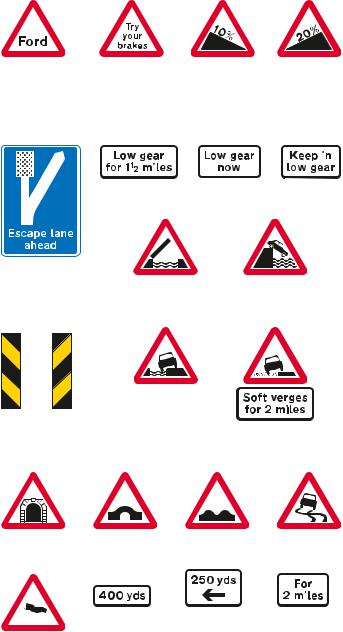
|
|
|
|
|
|
Worded warning. |
Try brakes after |
Steep hill |
Steep hill |
||
“Ford” may be |
crossing a ford |
downwards |
upwards |
||
varied to “Flood”, |
or before |
(10% is |
(20% is |
||
“Gate”, “Gates” |
descending a |
equivalent |
equivalent |
||
or “No smoking” |
steep hill |
to 1:10) |
to 1:5) |
||
|
|
|
|
|
|
|
|
|
|
|
|
|
|
|
|
|
|
|
|
|
|
|
|
Plates used with “steep hill” signs
Sign used with “steep hill” or “try your brakes” signs
End of bridge parapet, abutment wall, tunnel mouth etc.
Opening or |
Quayside or |
swing bridge |
river bank |
Water course alongside road
Soft verges for distance shown
Tunnel |
Hump bridge |
Uneven road |
Slippery road |
|
|
|
|
|
|
|
|
|
|
|
|
Distance to |
Distance and |
Distance over |
|
|||
|
hazard |
direction to |
which hazard |
Side winds |
hazard |
extends |
|
12
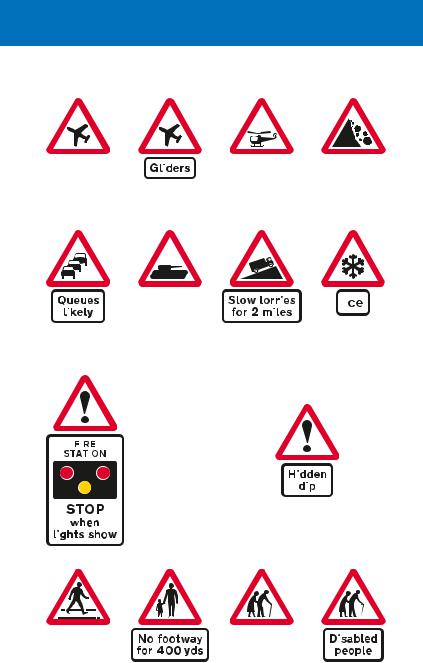
warning signs
Low-flying |
|
|
Low-flying |
Risk of falling |
|
|
|||
aircraft or |
|
|
helicopters |
or fallen rocks |
sudden |
Gliders likely |
or sudden |
|
|
aircraft noise |
|
|
helicopter noise |
|
|
|
|
|
Slow-moving |
|
|
|
|
|
|
|
|
|
|
|
|
|
|
|
||
|
|
|
|
military vehicles |
|
|
|
|
|
|
|
|
|
|
|
|
|
|
|
||
|
|
|
|
likely to be in |
|
|
|
Risk of ice. |
||
Traffic queues |
or crossing |
Slow-moving |
||||||||
“Ice” may |
||||||||||
likely ahead |
the road |
vehicles for |
||||||||
be varied to |
||||||||||
|
|
|
|
|
distance shown |
|||||
|
|
|
|
|
“Snowdrifts“ |
|||||
|
|
|
|
|
|
|
|
|||
|
|
|
|
|
|
|
|
|
|
|
|
|
|
|
|
|
|
|
|
|
|
|
|
|
|
|
|
|
|
|
|
|
|
|
|
|
|
|
|
|
|
|
|
|
|
|
|
|
|
|
|
|
|
|
|
|
|
|
|
|
|
|
|
|
|
|
Warning of signals |
|
|
|
|
|
|
|
|
|
|
|
(see page 120). |
|
|
|
“FIRE” may |
Other danger. The |
|
|
be varied to |
plate indicates the |
|
|
“AMBULANCE” |
nature of the hazard |
|
|
|||
|
|||
Zebra crossing |
Frail pedestrians |
|
|
|
|||
|
likely to cross |
||
Pedestrians in road |
Disabled |
||
for distance shown |
pedestrians. |
||
|
“Disabled” |
||
|
may be varied |
||
|
to “Blind” |
||
13
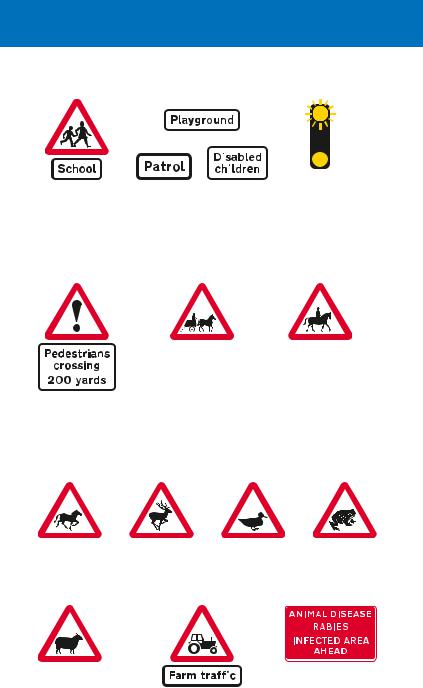
|
|
|
|
|
|
|
|
|
|
|
|
Children going to |
Alternative plates used |
||
or from school |
with “school” sign |
||
Pedestrians likely to be crossing a high-speed road where there is no formal crossing point
Horse-drawn vehicles likely to be in the road
Lights warning of children likely to be crossing the road on their way to or from school (used with “school” sign)
Accompanied horses or ponies likely to be in or crossing the road
Wild horses |
Wild animals |
Wild fowl |
Migratory |
or ponies |
|
|
toad crossing |
Sheep |
|
Area infected by |
|
||
|
|
animal disease |
Agricultural
vehicles
14
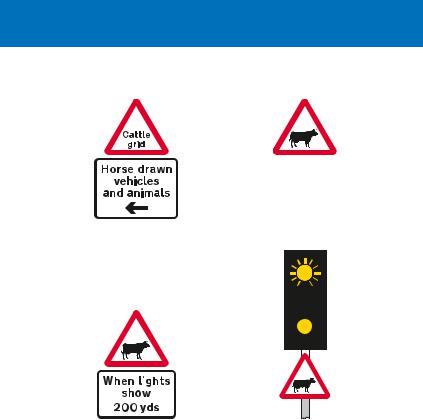
warning signs
Cattle
Cattle grid with indication of bypass for horse-drawn vehicles and animals
|
|
|
|
|
|
|
|
|
|
|
|
|
|
|
|
|
|
|
|
Supervised cattle |
Supervised |
||
crossing ahead |
cattle crossing |
||
15
